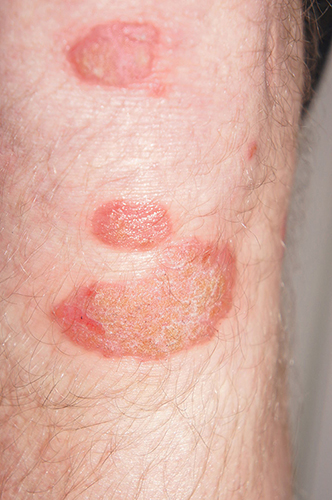by Claudia Curchin, David Jenkins and Hsien Herbert Chan, all from North Coast Dermatology
Kim Kardashian West, Cyndi Lauper and Art (Bridge Over Troubled Waters) Garfunkel are some of the world’s famous psoriasis sufferers, but lest the condition be thought to disproportionately affect singers, others in the celebrity club include author John Updike and golfer Phil Mickelson.
If the disease doesn’t target occupations it does tend to run in families – KKW’s mother is also a sufferer – but fortunately treatment options for patients with psoriasis have evolved considerably in recent years. Advances in dermato-immunology have been especially encouraging, with targeted “biologic” treatments for severe psoriasis.
Nine monoclonal antibodies are now available on the PBS for patients who have failed some of the more traditional treatments, and have a persistently high Psoriasis Area and Severity Index (“PASI score”). In this article we review the treatment options available, as well as aspects that are of particular interest to the general practitioner.
Psoriasis Treatment overview
Mild psoriasis can often be controlled with removal or avoidance of triggers, in conjunction with topical treatments which include emollients, topical steroids, tars, keratolytics, calcipotriol, and less commonly dithranol, topical calcineurin inhibitors, and retinoids. These treatments are often used in combination.
Another important first line measure is lifestyle change. Healthy living, managing stress, minimising alcohol and tobacco consumption are all thought to improve psoriasis in some people, and will mitigate against some of the metabolic associations of the disease. There is good evidence that weight loss in particular can have a tangible impact, not only on the psoriasis itself, but in sensitising patients to the effect of other treatments.
Step up treatments are usually required if these initial therapies are unsuccessful or unsuitable, the areas that are involved are likely to be resistant (e.g. nail psoriasis), or if the psoriasis is assessed as moderate or severe from the outset, and control with the agents used for mild psoriasis is unlikely. These measures include phototherapy (most commonly delivered as narrowband UVB), systemic retinoids (e.g. acitretin), or systemic immunosuppression (e.g.ciclosporin or methotrexate).
Whilst they are an excellent treatment for many patients, these traditional immunosuppressants have less efficacy and tolerability than the injectable biologic agents that target a specific immunological phenotype that is upregulated in psoriasis.
The most successful drugs have targeted the Th17 pathway, especially the IL-17, and IL-23 cytokines, although anti TNF agents were the first drugs in this category, and are still in use. Anti IL-23 antibodies (Guselkumab, Tildrakizumab, Rizankizumab), anti IL-17 antibodies (Secukinumab, Ixekizumab), anti IL-12/23 antibodies (Ustekinumab), and anti TNF antibodies (Adalimumab, Infliximab, Etanercept) are all PBS approved for severe psoriasis that is not responsive to other therapies.
Approximately half of all patients with severe psoriasis can expect a complete clearance of their skin with the newer biologics, with the vast majority of the others enjoying a significant improvement.
Patient and GP awareness of available therapies
Clearance (or at least optimal control) is usually achievable for patients who want it. Exactly what constitutes good control is different for each patient. Setting the metabolic associations of psoriasis aside, the impetus for treatment will be determined not only by the severity of the psoriasis, but also the affected sites, associated symptoms (itch, soreness, flaking/dandruff), and the patient’s wishes.
Whilst the concern for patients with psoriasis isn’t usually mortality, it often has a high morbidity. It will be of use for practitioners to know that for most patients the benefits of treatment usually outweigh its risks. If psoriasis isn’t adequately controlled with avoidance of triggers, lifestyle changes and topical therapies, then escalation to phototherapy or systemic treatment is indicated.
In the age of “Dr Google”, many patients will come to the GP having researched or heard about newer treatments that they would like to discuss, and it will be helpful for GPs to have an awareness in general terms as to where they fit in an Australian context. Conversely, there are still many patients with significant, treatable, chronic psoriasis that have inappropriately resigned themselves to thinking that they have to live with it.
A therapeutic alliance with the dermatologist
GPs play a critical and ongoing role in the health of psoriasis patients. Dermatologists will be looking to engage in a therapeutic team with the GP as they are particular keystones in:
• Optimisation of triggering medications. Certain medications, e.g. beta blockers, can exacerbate psoriasis and sometimes alternatives can be found that are equally therapeutic.
• Assessment and treatment of cardiovascular risk factors, psoriatic arthritis, depression/ anxiety and social supports.
• Weight loss counselling/planning.
• Smoking cessation.
• Working with the dermatologist to address any workforce implications.
• Some systemic therapies are contraindicated or at increased risk of complications with harmful alcohol intake, suboptimal blood pressure and diabetic control. Minimisation of these factors is very helpful.
• Supplying an up-to-date complete medical and medication history, as many systemic therapies have contraindications or interactions.
• Providing a central point of care, especially when multiple specialists are involved (e.g. for rheumatic or ocular complications, or comorbidities).
General Practitioners play an especially important role with patients on systemic therapies, especially in the lead up to initiation of a biologic. Considerations include:
• Monitoring for toxicities of ciclosporin – blood pressure and renal especially.
• Pre-immunosuppression work-up for the presence of chronic infections, autoimmunity or malignancy. Dermatologists will often order tests looking for tuberculosis, Hepatitis B and C, HIV, strongyloides exposure, varicella immunity, autoimmunity, paraproteinaemia. However, they rely on the GP to ensure that age-related malignancy screening is up to date, as immunosuppression should be avoided in the setting of active malignancy. A history of malignancy in the previous five years is a relative contraindication to immunosuppression.
• Ensuring vaccinations are up to date. Live vaccines are best given before treatment is started, as treatment must be stopped and washed out (with long half-lives) if a live vaccine is to be given. Inactivated vaccines are also best given off treatment to maximise the immune reaction, however, these can be given whilst on therapy if required.
• A travel assessment is beneficial to try and predict and plan for any indicated immunisations.
With more in the therapeutic toolbox, and collaboration between health practitioners, psoriasis patients can look forward to better outcomes. Indeed a bridge over troubled waters!
Psoriasis image - www.paul-hat-schuppenflechte.de / CC BY-SA
















